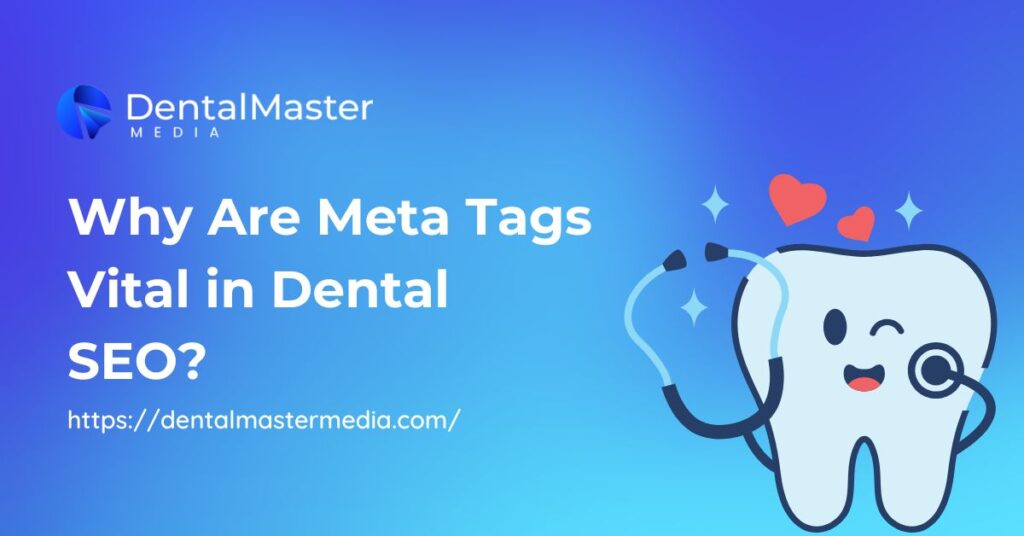Think of a search result like a tiny billboard. You have one short line for the title and a couple of short sentences for the description to convince a parent or patient to click your page instead of another clinic’s.
That tiny space is controlled by meta tags. When your tags are clear, relevant, and friendly, they guide search engines and real people to the right answer,your page. Strong, well-written tags are the foundation of effective Dental SEO.
Meta tags don’t require heavy code or a full redesign. You can improve them step by step and see real gains.
Even small lifts in click-through rate can add up. A few extra clicks per day become steady visits each month, which can lead to more calls and bookings.
What Meta Tags Are (Plain-English Guide)
The “title tag” that sets the first impression
The title tag is the clickable line in search results. It sets expectations for readers and signals your main topic to search engines.
Because it is visible and compact, the title tag is one of the strongest on-page elements you control.
A clear, patient-focused title,such as “Emergency Dentist ,Same-Day Relief”,helps your page appear for the right searches and gives searchers the confidence to click.
A good title avoids filler and repeats. It uses natural words a patient would type. It promises a benefit without sounding pushy. It matches the content on the page so the visitor feels they arrived in the right place.
When crafted well, a title tag can support the work of a Local Dental SEO Company by improving both visibility and click-through rates.
The meta description that earns the click
The meta description sits under the title in search results. It may not be a direct ranking factor, but it strongly affects clicks.
A helpful description gives a quick reason to visit your page. It should highlight a benefit and a next step, such as “Gentle care, flexible hours, and simple online booking.” This style respects the reader’s time and reduces doubt.
Write your description for humans first. Keep it specific, avoid repeating your clinic name unless it adds clarity, and use plain words.
If the page focuses on a service, mention comfort, timing, cost guidance, or booking to move the reader forward.
Other helpful tags: robots, canonical, viewport, Open Graph
Meta robots tell search engines what to do with a page. You can index public pages and hide private ones such as thank-you or test pages. This keeps your search results clean and focused on pages that matter.
Canonical tags tell search engines which version of a similar page is the main one. If your site has pages with small variations, a canonical funnel signals to the primary version.
This helps prevent diluted relevance and avoids confusion in results.Viewport makes pages fit smaller screens. Since many searches happen on phones, a correct viewport setting supports an easy reading experience.
Open Graph and Twitter Cards control how your pages look when shared on social apps.
A neat preview image and a short, inviting description can bring more visitors from social posts and messages.
Why Meta Tags Matter for Dental Clinics
Visibility and relevance signals
Meta tags help search engines understand what your page is about. Clear titles and descriptions make the topic obvious and match it to real questions patients ask.
When the focus is tight and the benefits are easy to read, you increase the chance that your page is shown to the right person at the right time.
This focused approach sits at the heart of Dental SEO, because it aligns your content with patient intent.
Click-through rate (CTR) and patient trust
Two pages can rank next to each other, yet the one with a better description often wins the click.
People look for signs of comfort, speed, cost clarity, and easy next steps. If your tags speak to those needs, readers feel understood.
Over time, better CTR sends a positive signal about relevance and can help your listing hold or improve its position.
Duplicate control and clean indexing
Similar pages can confuse search engines and split signals. Canonical tags and thoughtful use of meta robots help you keep one main version in the index.
Clean indexing stops the wrong page from appearing for a key term and makes your site map easier to follow for both bots and people.
How to Write High-Impact Meta Tags
Character counts that fit
Aim for titles that fit within common display limits, roughly 50 to 60 characters. Keep descriptions around 150 to 160 characters.
These ranges help prevent cut-offs on many devices. They are guidelines, not strict rules, but staying close helps your message appear as you wrote it.
Add patient-friendly benefits and calls to action
Most readers scan. They want outcomes and simple steps. A strong description names a clear benefit,like fast help, gentle care, or clear timelines,and points to an action, such as booking online or calling now. This focus respects the moment and reduces hesitation.
Tone matters. Use calm, direct language. Avoid hype. Make the next step feel easy and safe. When the page delivers on what the tag promises, trust grows and bounce rates fall.
Make them local and service-focused
Service pages should target a single intent. An emergency page speaks to urgent help. An orthodontics page speaks to straightening and comfort. A hygiene page speaks to freshness and prevention.
If you serve a set area, refer to your service area in plain terms, without stuffing names into every tag. Keep each page distinct so search engines can align it with a matching query.
Examples for Common Dental Pages
General dentist / family dentist
A family page can use reassuring titles such as “Family Dentist , Friendly Care, Easy Booking.”
The description might mention check-ups, fillings, comfort, and a quick way to book. This approach sets expectations and gives readers a reason to visit your page first.
When paired with Advanced Dental SEO Services, it also strengthens visibility by aligning the page with patient-friendly language and search intent.

Emergency dentist
An emergency page needs direct language. A title like “Emergency Dentist , Same-Day Relief” works because it addresses urgency without drama.
The description can note fast help, extended hours, and the call action. People in pain want simple, clear steps.
Orthodontics, implants, and hygiene pages
An orthodontics page can promise clarity around options and timelines. An implants page can mention a stable bite and natural look, along with a friendly consultation about comfort and cost.
A hygiene page can point to freshness, stain removal, and prevention tips. In each case, the tag states who it helps, the outcome, and the next step.
Quality Checks and Ongoing Optimisation
Avoid common mistakes
Missing or duplicate titles create confusion and waste potential. Vague descriptions like “We offer many services” say very little. Keyword stuffing looks spammy and can hurt trust. Over-long tags risk truncation. Promises made in tags must be explained on the page. Consistency between snippet and content keeps readers on your site longer.
Test, measure, and improve
Watch impressions, clicks, and CTR in your search performance reports. If a page gets many impressions but few clicks, refresh the title and description. Keep a simple change log with dates and versions so you can see what worked.
Give each test enough time to collect data before judging results. Even a small CTR lift can deliver steady growth over a quarter.
Internal linking opportunities to amplify results
Meta tags win the first click; internal links guide the next one. On an orthodontics page, link to a finance guide.
On an emergency page, link to a “what to do at home” article. On an implants page, link to sedation and after-care.
Use clear anchor text so readers know what they’ll get. These paths help both patients and search engines understand your site.
Supporting Details: Examples, Light Stats, Patient-Focused Scenarios
Think of a parent searching late at night for a sore tooth. A clear emergency title and welcoming description can win their click. Someone comparing braces and aligners will pause on a tag that mentions comfort and timelines.
A patient worried about cost feels reassured by a description that points to a simple consult and upfront fees. Strong tags create the first impression and reduce hesitation.
Step-by-Step: A Practical Meta Tag Workflow
List your key pages,home, core services, and top articles. Write titles and descriptions focused on one question each page answers.
Add benefits and a simple action. Keep within length limits. Avoid duplicates, set canonicals, and monitor CTR. Update tags for seasonal changes or new hours.
Advanced Considerations (Still Simple to Apply)
Give each location page its own distinct title and description with area names. Mention time-limited offers during campaigns.
Use Open Graph and Twitter Cards for clean shares. Mark thank-you or filter pages as “noindex” so results stay tidy.
Where Meta Tags Fit in Your Bigger Plan
Meta tags sit alongside headings, content, and speed,but they often decide whether someone clicks. Focus each tag on one intent.
At Dental Master Media, we recommend pairing each high-value page with a clear title, helpful description, and two or three internal links to guide readers.
A Note on Consistency and Brand Voice
Write in the same tone your team uses with patients: calm, clear, and friendly. Avoid jargon and hype. Keep the style consistent across pages, but vary wording to avoid duplicates.
Putting It All Together (Mini Checklist)
- Unique title and description for every page
- Clear page focus with one main need
- Mention service area naturally
- Add benefits and a simple action
- Avoid keyword stuffing
- Set canonicals for overlaps
- Hide non-public pages with meta robots
- Add Open Graph for clean shares
- Track clicks and refresh when performance dips
Quick Reminders About the Two Big Wins
First, tags shape your first impression in results. A focused title and a helpful description make clicking your page feel safe and smart.
Second, small CTR gains across several pages can stack into steady traffic growth. Over time, these gains support more calls, messages, and bookings.
Strong tags are a practical pillar of Dental SEO because they match your pages to real intent and help people take the next step.
Conclusion
Meta tags give you control over what searchers see and how they feel in the moment they choose where to click.
A focused title guides the right search, a clear description invites the visit, and careful use of robots and canonicals keeps your index tidy.
When you keep tags straightforward, service-focused, and aligned with what is on the page,and you review them regularly,you build steady gains that support your wider content and booking goals.
If you’d like a friendly audit or a short plan to refresh your tags, the team at Dental Master Media can help you review, tidy up, and keep improving over time.

Suraj Rana is the owner of Dental Master Media and a leading expert in SEO for dental practices. With a passion for dental marketing, he has successfully helped numerous dental clinics climb the search engine ranks. Suraj’s expertise makes him a go-to resource for effective, results-driven dental marketing.

